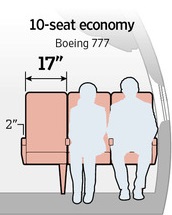 “Nothing is true about airlines” is a mantra used often by avid travelers, especially in these days of receiving the bare minimum in service.
“Nothing is true about airlines” is a mantra used often by avid travelers, especially in these days of receiving the bare minimum in service.
Business Travel Columnist Joe Brancatelli analyzed the latest survey from the Bureau of Transportation Statistics and found nine facts about airlines today that may just drive you bonkers.
Fares are up.
Well, duh. Anyone who’s flown in the recent future can tell you that. But, the average domestic airfare went up 5.1 percent (from $390 to $371) since the third-quarter of 2012, and fares adjusted for inflation were the highest since 2003.
Fares are down.
You’re probably thinking, “Huh?” You may want to blame the de-bundling debacle for this one. Average fares dropped 1.9 percent in the three-year period between 2010 and 2013. Last year’s third quarter yielded an average fare of $390, down 14 percent from $453 in 2000. Compare the 14 percent fare decline with a 34.8 percent increase in overall consumer prices.
United Airlines charges the most.
United Airlines controls three of the five airports with the highest average fares in the nation, with Newark at $491, Washington Dulles at $506 and Houston Bush Intercontinental at $507. But, the priciest airport in the country is still Huntsville, Alabama, where passengers pay an average of $559 due to AirTran Airways’ departure.
Delta does Atlanta.
The majority of America’s busiest airport is controlled by Delta Air Lines (68.3 percent), and Atlantans are paying dearly for the privilege – an average of $432, up 22.6 percent since 2012. Fares are also rising quickly in Colorado Springs (20.4 percent), New York’s White Plains (15.8 percent) and Florida’s Fort Myers (15.1 percent).
Low Roller.
Which airport has the nation’s lowest average fare, you ask? That title goes to New Jersey gambling town Atlantic City, where the average fare in 2013 was $157. But don’t let the uncharacteristically low fare fool you: the price is still up 16.5 percent year over year, which makes Atlantic City the third highest price increase in the nation.
Let’s get small.
The smaller cities are what saw the largest average fare decreases. Prices in Bellingham, Washington declined by 16.4 percent; Charleston, South Carolina dropped 8.1 percent; Providence, Rhode Island dropped 6.7 percent; Burlington, Vermont; and 3.2 percent in Manchester, New Hampshire. Charleston’s price-drop can be attributed to the arrival of JetBlue Airlines, while Southwest dominates Manchester (60 percent) and Providence (50 percent), and low-cost carriers Allegiant, Frontier and Sun Country serve Bellingham.
Our place in fare history.
When the BTS started compiling price data in 1995, it listed the average fare as $439, meaning airfares have remained fairly low compared to prices in the last 20 years. Currently, we’re down 11.2 percent with the current average fare of $390. During the same time, the general inflation rate was 52.87 percent, according to the BTS reading of the Consumer Price Index.
The takeaway.
Is it possible for the fares to be down even though the national inflation rate soared? Absolutely. Consider that the “average” fare still includes leisure travelers who occasionally score a $69 fare to Florida. But be weary: comparing quality of fares from 1995 to 2013 is the same apple-and-oranges argument.
Think about it: in 1995, airfare included two or three checked bags with a hefty weight limit, seat assignments, by-your-row boarding privileges, a full meal, better service— the list goes on. Everyone knows the modern unbundling scheme, forcing you to pay for your seat of choice and early boarding, and fees like changing a nonrefundable ticket, which have soared to a whopping $200 on more domestic flights. Finally, the seat you’re buying today is probably much narrower with less legroom and located on a much smaller and more uncomfortable aircraft than in 1995.

 Save up to 60% on Business Class. Call 1-800-435-8776
Save up to 60% on Business Class. Call 1-800-435-8776
[…] to fly to Barcelona? Well, if your airline of choice is American, which doesn’t fly to there, you’ll actually be flying with British […]